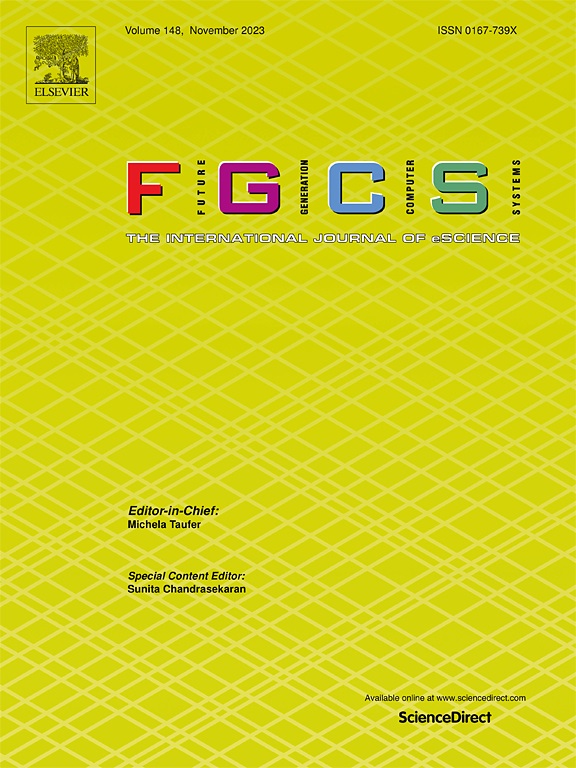An intelligent native network slicing security architecture empowered by federated learning
IF 6.2
2区 计算机科学
Q1 COMPUTER SCIENCE, THEORY & METHODS
Future Generation Computer Systems-The International Journal of Escience
Pub Date : 2024-10-02
DOI:10.1016/j.future.2024.107537
引用次数: 0
Abstract
Network Slicing (NS) has transformed the landscape of resource sharing in networks, offering flexibility to support services and applications with highly variable requirements in areas such as the next-generation 5G/6G mobile networks (NGMN), vehicular networks, industrial Internet of Things (IoT), and verticals. Although significant research and experimentation have driven the development of network slicing, existing architectures often fall short in intrinsic architectural intelligent security capabilities. This paper proposes an architecture-intelligent security mechanism to improve the NS solutions. We idealized a security-native architecture that deploys intelligent microservices as federated agents based on machine learning, providing intra-slice and architectural operation security for the Slicing Future Internet Infrastructures (SFI2) reference architecture. It is noteworthy that federated-learning approaches match the highly distributed modern microservice-based architectures, thus providing a unifying and scalable design choice for NS platforms addressing both service and security. Using ML-Agents and Security Agents, our approach identified Distributed Denial-of-Service (DDoS) and intrusion attacks within the slice using generic and non-intrusive telemetry records, achieving an average accuracy of approximately 95.60% in the network slicing architecture and 99.99% for the deployed slice – intra-slice. This result demonstrates the potential for leveraging architectural operational security and introduces a promising new research direction for network slicing architectures.
由联合学习赋能的智能本地网络切片安全架构
网络切片(NS)改变了网络资源共享的格局,为支持下一代 5G/6G 移动网络(NGMN)、车载网络、工业物联网(IoT)和垂直行业等领域需求千变万化的服务和应用提供了灵活性。尽管大量的研究和实验推动了网络切片的发展,但现有的架构往往缺乏内在的架构智能安全能力。本文提出了一种架构智能安全机制,以改进 NS 解决方案。我们理想化了一种安全原生架构,将智能微服务部署为基于机器学习的联盟代理,为未来互联网基础设施切片(SFI2)参考架构提供片内和架构操作安全。值得注意的是,联合学习方法与基于微服务的高度分布式现代架构相匹配,从而为解决服务和安全问题的 NS 平台提供了统一且可扩展的设计选择。通过使用 ML 代理和安全代理,我们的方法利用通用和非侵入式遥测记录识别了切片内的分布式拒绝服务(DDoS)和入侵攻击,在网络切片架构中实现了约 95.60% 的平均准确率,在部署的切片-切片内实现了 99.99% 的平均准确率。这一成果展示了利用架构运行安全的潜力,并为网络切片架构引入了一个前景广阔的新研究方向。
本文章由计算机程序翻译,如有差异,请以英文原文为准。
求助全文
约1分钟内获得全文
求助全文
来源期刊
CiteScore
19.90
自引率
2.70%
发文量
376
审稿时长
10.6 months
期刊介绍:
Computing infrastructures and systems are constantly evolving, resulting in increasingly complex and collaborative scientific applications. To cope with these advancements, there is a growing need for collaborative tools that can effectively map, control, and execute these applications.
Furthermore, with the explosion of Big Data, there is a requirement for innovative methods and infrastructures to collect, analyze, and derive meaningful insights from the vast amount of data generated. This necessitates the integration of computational and storage capabilities, databases, sensors, and human collaboration.
Future Generation Computer Systems aims to pioneer advancements in distributed systems, collaborative environments, high-performance computing, and Big Data analytics. It strives to stay at the forefront of developments in grids, clouds, and the Internet of Things (IoT) to effectively address the challenges posed by these wide-area, fully distributed sensing and computing systems.

 求助内容:
求助内容: 应助结果提醒方式:
应助结果提醒方式:


